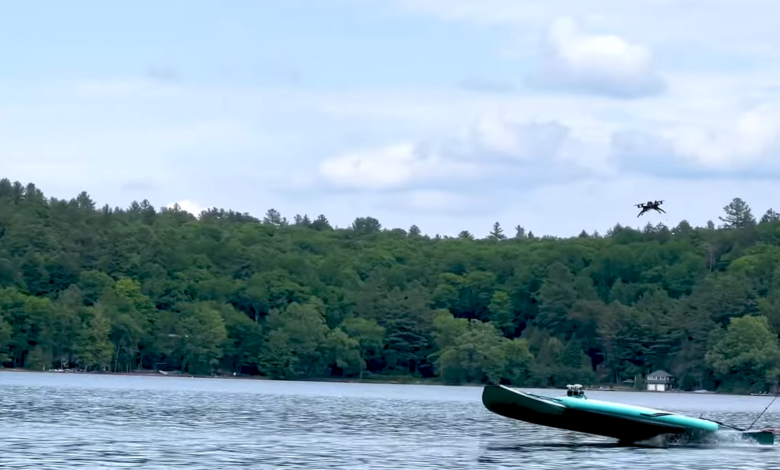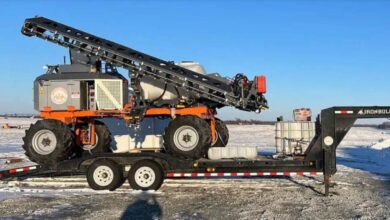Video Friday: Drone vs. Flying Canoe

Video Friday is your weekly selection of awesome robotics videos, collected by your friends at IEEE Spectrum robotics. We also post a weekly calendar of upcoming robotics events for the next few months. Please send us your events for inclusion.
RoboCup 2024: 17–22 July 2024, EINDHOVEN, NETHERLANDS
ICRA@40: 23–26 September 2024, ROTTERDAM, NETHERLANDS
IROS 2024: 14–18 October 2024, ABU DHABI, UAE
ICSR 2024: 23–26 October 2024, ODENSE, DENMARK
Cybathlon 2024: 25–27 October 2024, ZURICH
Enjoy today’s videos!
There’s a Canadian legend about a flying canoe, because of course there is. The legend involves drunkenness, a party with some ladies, swearing, and a pact with the devil, because of course it does. Fortunately for the drone in this video, it needs none of that to successfully land on this (nearly) flying canoe, just some high-friction shock absorbing legs and judicious application of reverse thrust.
[ Createk ]
Thanks, Alexis!
This paper summarizes an autonomous driving project by musculoskeletal humanoids. The musculoskeletal humanoid, which mimics the human body in detail, has redundant sensors and a flexible body structure. We reconsider the developed hardware and software of the musculoskeletal humanoid Musashi in the context of autonomous driving. The respective components of autonomous driving are conducted using the benefits of the hardware and software. Finally, Musashi succeeded in the pedal and steering wheel operations with recognition.
Thanks, Kento!
Robust AI has been kinda quiet for the last little while, but their Carter robot continues to improve.
[ Robust AI ]
One of the key arguments for building robots that have similar form factors to human beings is that we can leverage the massive human data for training. In this paper, we introduce a full-stack system for humanoids to learn motion and autonomous skills from human data. We demonstrate the system on our customized 33-degrees-of-freedom 180 centimeter humanoid, autonomously completing tasks such as wearing a shoe to stand up and walk, unloading objects from warehouse racks, folding a sweatshirt, rearranging objects, typing, and greeting another robot with 60-100 percent success rates using up to 40 demonstrations.
[ HumanPlus ]
We present OmniH2O (Omni Human-to-Humanoid), a learning-based system for whole-body humanoid teleoperation and autonomy. Using kinematic pose as a universal control interface, OmniH2O enables various ways for a human to control a full-sized humanoid with dexterous hands, including using real-time teleoperation through VR headset, verbal instruction, and RGB camera. OmniH2O also enables full autonomy by learning from teleoperated demonstrations or integrating with frontier models such as GPT-4.
[ OmniH2O ]
A collaboration between Boxbot, Agility Robotics, and Robust.AI at Playground Global. Make sure and watch until the end to hear the roboticists in the background react when the demo works in a very roboticist way.
::clap clap clap:: yaaaaayyyyy….
[ Robust AI ]
The use of drones and robotic devices threatens civilian and military actors in conflict areas. We started trials with robots to see how we can adapt our HEAT (Hostile Environment Awareness Training) courses to this new reality.
[ CSD ]
Thanks, Ebe!
How to make humanoids do versatile parkour jumping, clapping dance, cliff traversal, and box pick-and-move with a unified RL framework? We introduce WoCoCo: Whole-body humanoid Control with sequential Contacts
[ WoCoCo ]
A selection of excellent demos from the Learning Systems and Robotics Lab at TUM and the University of Toronto.
[ Learning Systems and Robotics Lab ]
Harvest Automation, one of the OG autonomous mobile robot companies, hasn’t updated their website since like 2016, but some videos just showed up on YouTube this week.
Northrop Grumman has been pioneering capabilities in the undersea domain for more than 50 years. Now, we are creating a new class of uncrewed underwater vehicles (UUV) with Manta Ray. Taking its name from the massive “winged” fish, Manta Ray will operate long-duration, long-range missions in ocean environments where humans can’t go.
[ Northrop Grumman ]
Akara Robotics’ autonomous robotic UV disinfection demo.
[ Akara Robotics ]
Scientists have computationally predicted hundreds of thousands of novel materials that could be promising for new technologies—but testing to see whether any of those materials can be made in reality is a slow process. Enter A-Lab, which uses robots guided by artificial intelligence to speed up the process.
[ A-Lab ]
We wrote about this research from CMU a while back, but here’s a quite nice video.
[ CMU RI ]
Aw yiss pick and place robots.
[ Fanuc ]
Axel Moore describes his lab’s work in orthopedic biomechanics to relieve joint pain with robotic assistance.
[ CMU ]
The field of humanoid robots has grown in recent years with several companies and research laboratories developing new humanoid systems. However, the number of running robots did not noticeably rise. Despite the need for fast locomotion to quickly serve given tasks, which require traversing complex terrain by running and jumping over obstacles. To provide an overview of the design of humanoid robots with bioinspired mechanisms, this paper introduces the fundamental functions of the human running gait.
[ Paper ]



